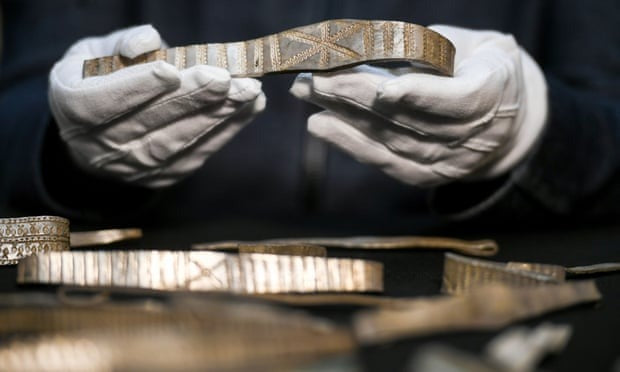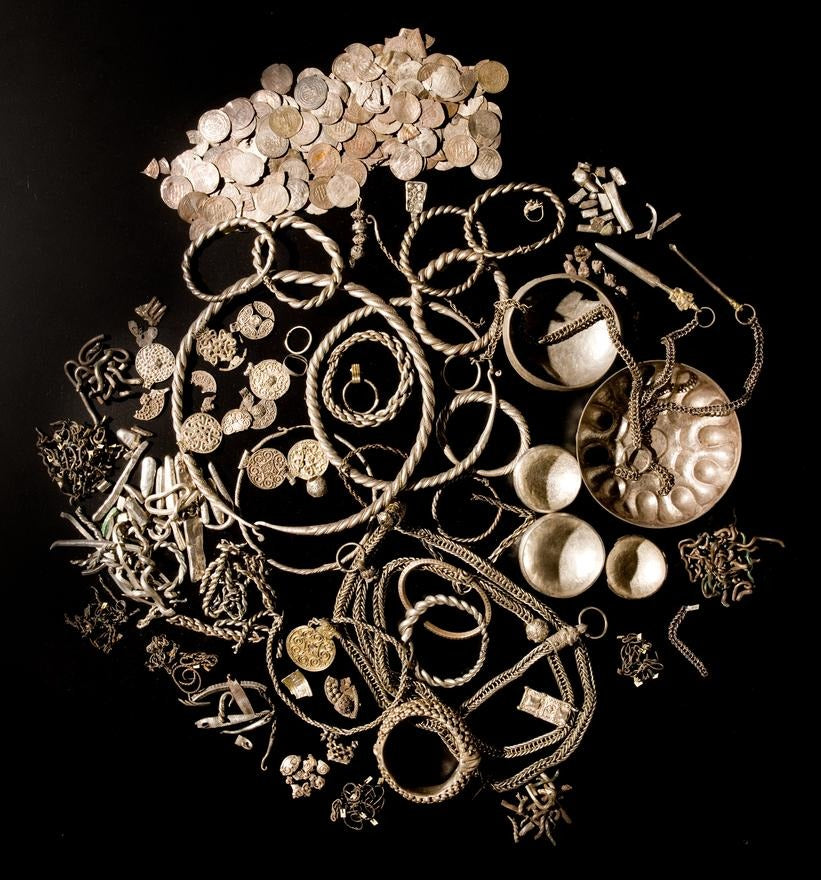Article: Unveiling the Mysteries of the Galloway Hoard: A Tale of Intrigue and Heritage

Unveiling the Mysteries of the Galloway Hoard: A Tale of Intrigue and Heritage
A Remarkable Discovery
In the heart of Scotland's historical landscape lies a treasure trove that has captured the imagination of historians, archaeologists, and enthusiasts alike—the Galloway Hoard. Discovered in 2014 by a metal detectorist in Balmaghie, Kirkcudbrightshire, this extraordinary collection transcends mere riches. Its significance extends beyond material value, offering a glimpse into the intricate tapestry of Viking Age Scotland and its connections to distant lands.
Ritualistic Burial and Cultural Significance
Traditionally, the prevailing belief surrounding hoards from the Viking Age has been one of frantic concealment—a desperate bid to safeguard wealth from marauding invaders. However, the Galloway Hoard challenges this entrenched narrative, inviting us to reconsider the complexities of ancient practices.

Photography by Nill Hanna - An Anglo Saxon pectoral cross from the Galloway Hoard.
Recent revelations, brought to light by research and analysis, paint a different picture altogether. Instead of a hurried act of preservation, scholars now posit that the Galloway Hoard was carefully curated and interred with deliberate intent. This departure from convention offers a tantalizing glimpse into the intricate rituals and beliefs of Viking Age society.

Through painstaking examination of the artefacts and their arrangement, researchers have discerned a pattern of deliberate assembly within the Galloway Hoard. Each item appears to have been selected with care, reflecting not only material wealth but also symbolic significance. This deliberate curation suggests a profound reverence for the objects and their cultural significance.
The revelation that the Galloway Hoard was not hastily stashed away but rather reverently buried challenges preconceived notions about Viking Age behaviour. It prompts us to reconsider the motivations behind such acts and the cultural values that underpinned them. Far from mere acts of preservation, these rituals may have served deeper symbolic and ceremonial purposes, reflecting a complex tapestry of beliefs and practices.

Photography by Jeff J Mitchell - Artistic brooches discovered in the Galloway Hoard
This newfound understanding of the Galloway Hoard offers valuable insights into the social dynamics and cultural practices of Viking Age society. It compels us to move beyond simplistic narratives of plunder and survival, acknowledging the depth and complexity of ancient civilizations. By illuminating the motivations behind such acts of ritualistic burial, we gain a richer understanding of the individuals and communities that inhabited this fascinating era.
The Roman Rock Crystal Jar

Photography by Neil Hanna © - National Museums Scotland
Nestled within the depths of the Galloway Hoard lies a treasure of unparalleled significance—an exquisite Roman rock crystal jar adorned with intricate layers of gold thread. Despite its unassuming size of merely 5 cm in height, this remarkable artefact encapsulates a wealth of historical and cultural significance that transcends its diminutive stature.

Detail of the goldwork on the baseplate showing different kinds of gold filigree ornament and granulation. Photography by Neil Hanna © - National Museums Scotland
The origins of the rock crystal jar can be traced back to the heart of the Roman Empire, where skilled artisans crafted it with meticulous precision centuries before the Viking Age dawned. Carved from a single piece of rock crystal, this jar stands as a testament to the ingenuity and craftsmanship of ancient civilizations, showcasing their mastery of intricate artistry and materials.

The presence of the Roman rock crystal jar within the Galloway Hoard serves as a poignant reminder of the interconnectedness of ancient civilizations. Its journey from the heart of the Roman Empire to the shores of Viking-age Scotland speaks to the vibrant networks of trade and cultural exchange that flourished during this era. Through the exchange of goods and ideas, distant lands were brought together in a tapestry of diversity and richness.
As scholars delve deeper into the intricacies of the Galloway Hoard, the Roman rock crystal jar emerges as a key to unlocking mysteries of the past. Its presence among the treasures of the hoard offers tantalizing clues about the cultural practices, beliefs, and aspirations of the individuals who inhabited this fascinating era. Through careful analysis and interpretation, we gain valuable insights into the complex tapestry of human history and the enduring legacy of ancient civilizations.
Dr. Martin Goldberg's Insights

Dr Martin Goldberg, holding one of the gold objects found in the wooden box in one of its several parcels.
Dr. Martin Goldberg, an esteemed authority in the field of Medieval archaeology and the principal curator at Scotland's National Museums, brings invaluable insights into the significance of the Roman rock crystal jar within the context of the Galloway Hoard. Describing it as "a really surprising and unique object," Dr. Goldberg underscores the exceptional nature of this discovery, highlighting its ability to transcend temporal and geographical boundaries.
"Nothing like this has ever been found in Scotland . . . research so far is pointing to a new understanding of Scotland in the international context of the earliest Viking Age."
- Dr Martin Goldberg, Principal Curator of Medieval Archaeology and History
Moreover, the inscription found on the base of the jar adds another layer of intrigue to its narrative. Bearing the name "Bishop Hyguald," this inscription serves as a tantalizing clue linking the hoard to the Anglo-Saxon kingdom of Northumbria. In doing so, it opens up new avenues for exploration, inviting researchers to delve deeper into the historical connections and cultural exchanges that shaped the world of the Vikings.

The gold baseplate of the rock crystal jar, showing a Latin inscription rendered in gold wire and granulesation. The name Hyguald begins at the top left corner. Photography by Neil Hanna © - National Museums Scotland
Cultural Exchange and Diversity
The Galloway Hoard serves as a profound testament to the dynamic cultural landscape of the Viking Age, highlighting the interconnectedness and exchange of ideas that characterized this pivotal period in history. Beyond its material value, the hoard embodies the diverse tapestry of cultures that converged in ancient Scotland, reflecting the vibrant interplay between different societies.

A selection of silver broad-band arm-rings, which were originally penannular but have been flattened
Through the eclectic array of artefacts found within the hoard, ranging from intricately crafted jewelry to exotic textiles, we gain insights into the cosmopolitan nature of Viking-era Scotland. These artifacts not only showcase the artistic prowess of their creators but also bear witness to the cross-cultural influences that shaped their design and craftsmanship. The presence of items originating from distant lands underscores Scotland's role as a hub of trade and cultural exchange, where goods and ideas flowed freely across geographical boundaries.
 A selection of beads, including a large 'melon' style bead with ribbed edge, and slightly yellowed clear glass
A selection of beads, including a large 'melon' style bead with ribbed edge, and slightly yellowed clear glass
Moreover, the diversity of materials and styles represented in the hoard speaks to the multicultural fabric of ancient Scottish society. From Anglo-Saxon influences to traces of Roman heritage, each artifact tells a story of cultural fusion and adaptation, highlighting the dynamic nature of identity in the Viking Age. By examining these artifacts within their broader historical context, we gain a deeper appreciation for the richness and complexity of Scotland's cultural heritage, shaped by centuries of interaction and exchange.
Speculations and Clues
The mystery surrounding the origins of the Galloway Hoard adds an intriguing layer to its narrative, prompting speculation and scholarly debate among archaeologists and historians. One of the most compelling hypotheses suggests that the hoard was meticulously assembled and buried by four individuals representing different social strata within Viking Age society. This theory posits that each contributor played a unique role in the creation of this captivating collection of artefacts, reflecting their distinct status and cultural affiliations.

Gold objects found in wooden box in one of the parcels
The presence of Anglo-Saxon inscriptions within the hoard further deepens the enigma surrounding its origins. These inscriptions, believed to be names or symbols of ownership, offer tantalizing clues about the diverse cultural landscape of Viking Age Scotland. The coexistence of Viking and Anglo-Saxon influences hints at a complex web of interactions and exchanges between different ethnic and linguistic groups during this period.
As archaeologists continue to unravel the secrets of the Galloway Hoard, each new discovery adds another piece to the puzzle, shedding light on the lives and identities of the individuals who contributed to its creation. Speculations abound regarding the motivations behind the hoard's burial and the significance of its contents, fueling fascination and curiosity about this extraordinary archaeological find. Ultimately, the Galloway Hoard serves as a testament to the rich tapestry of cultures that once thrived in ancient Scotland, inviting us to delve deeper into the complexities of its past.

Unveiling Scotland's Heritage
The ongoing research into the Galloway Hoard represents more than just a quest to uncover ancient artifacts—it is a journey of exploration into Scotland's rich and diverse heritage. With each new revelation, we gain deeper insights into the lives, beliefs, and aspirations of the people who inhabited this ancient land.

The Galloway Hoard serves as a poignant reminder of the enduring allure of the past, drawing us into a captivating narrative that transcends time. As we peel back the layers of history, we uncover stories that have long been hidden beneath the surface, waiting to be rediscovered and shared with the world.
This extraordinary collection of artifacts invites us to embark on a journey of discovery and enlightenment, offering a glimpse into the cultural tapestry of ancient Scotland. It reminds us that behind every object lies a story, waiting to be told and understood in the context of its time and place.
As we continue to unravel the mysteries of the Galloway Hoard, we not only enrich our understanding of the past but also forge a deeper connection to our shared heritage. It is a testament to the resilience of human curiosity and the enduring legacy of those who came before us, urging us to preserve and celebrate Scotland's vibrant history for generations to come.
Citations:
Archaeology, S.H. (2023) The Galloway Hoard, National Museums Scotland. Available at: https://www.nms.ac.uk/explore-our-collections/stories/scottish-history-and-archaeology/galloway-hoard/ (Accessed: 16 March 2024).
Campsie, A. (2021) Mystery of the four people who buried the spectacular Galloway Hoard of Viking Treasures, The Scotsman. Available at: https://www.scotsman.com/heritage-and-retro/heritage/mystery-of-the-four-people-who-buried-the-spectacular-galloway-hoard-of-viking-treasures-3252413 (Accessed: 16 March 2024).
Cowie, A. (2021) Galloway Hoard Restoration reveals more surprising secrets, Ancient Origins Reconstructing the story of humanity’s past. Available at: https://www.ancient-origins.net/news-history-archaeology/galloway-hoard-0015380 (Accessed: 16 March 2024).
Galloway Hoard (2023) Wikipedia. Available at: https://en.wikipedia.org/wiki/Galloway_Hoard (Accessed: 16 March 2024).







